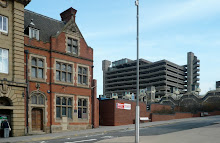
Richard Rigg, 'A Clearing' 2012, Corrugated Iron, Lead, Featherboard, Oak Beams, Siberian Pine, Plywood, Timber, Fibreglass, Glue, String, Nails, Screws, Iron Hinges, Latch, Paint, Carbide Lamp, Bulb, Cable, Wire, Plastic tubing, Newspaper, Castors, Peat, Twigs, Feather, Various Soils, Granite, Gneiss, Sandstone, Basal Quartzite, Limestone, Slate, Rainwater, Festuca Ovina, Gnaphalium supine, Deschampsia flexuosa, Carex capillaries, Carex curvata, Calluna vulgaris, Muhlenbergia rigens, Tortula Muralis, Dicranoweisia crispula, Sphagnum mosses, Tortella bambergeri, Cobwebs, Dust. 340 x 510 x 390 cm, Installation View: BALTIC Centre for Contemporary Art, Photo: Colin Davison, Courtesy of the Artist and Workplace Gallery, UK
Richard Rigg
'Visual Artist of the Year'
Journal Culture Awards
Workplace Gallery is delighted to congratulate Richard Rigg on being awarded 'Visual Artist of the Year' 2012 at the Journal Culture Awards hosted at Durham Cathedral last night.
In 2012 Rigg's solo exhibitions included 'The Inhabitant of the Watchtower' at High Desert Test Sites, Joshua Tree, USA commissioned by Circa Projects; and 'LACUNA' at BALTIC Centre for Contemporary Art for which he produced his most ambitious work to date 'A Clearing':
The ambiguous title of the work could refer to that moment where you finally find yourself out of the trees in an open space of a forest, an instance of apparent clarity or, conversely, it could signify something being erased. In the exhibition space visitors find a mountain cabin. Invited inside, they discover its interior to be a mountain landscape alive with plants. The project began with Rigg's observation of fog over a mountain and his meditation on how the mountain could at once be both absent and present. 'A Clearing' also uncovers our complex potential connections and disconnections with landscape. Un-tethered from time and place, the cabin is a design hybrid taken from many sources from various periods. The landscape found within it is unremarkable and has no discerning features. Its rocks and stones are mainly taken from Torridon, a series of mountains in the Scottish Highlands, and are largely from the little-known Precambian period that predates human life. Repositioned within the manmade structure of the hut, these natural objects reflect how our understanding of the past is framed and constructed. The contained mountain also provokes our capacity to imagine a space beyond our known landscape.
Richard Rigg was born in Cumbria in 1980. He holds a BA in Fine Art from Newcastle University and was nominated for the Northern Art Prize in 2011. Recent exhibitions include: 'Glamourie', PSL, Leeds, UK; 'Quiet Works', Temple Contemporary, Philadelphia, USA; 'Broken Fall (organic)', Galleria Enrico Astuni, Bologna, Italy; 'The Glass Delusion', The National Glass Centre, Sunderland, UK; Richard Rigg 'Holography', Workplace Gallery, Gateshead, UK. He completed a residency at Eilean Shona, Scotland in 2012.
|
|







